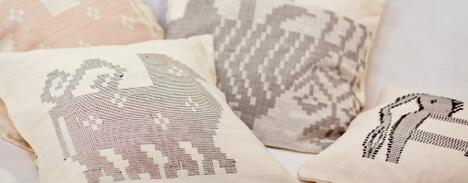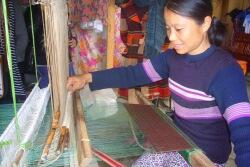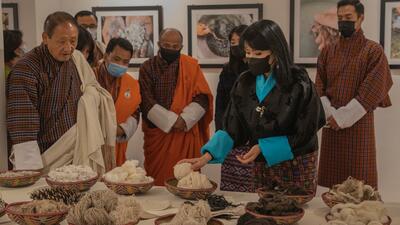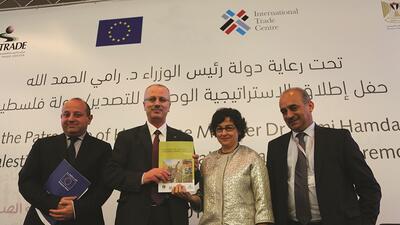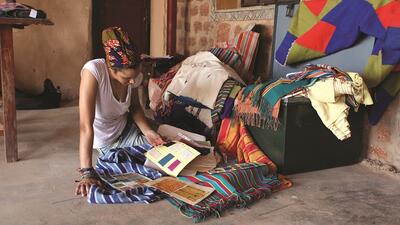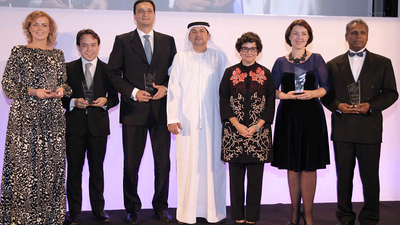Crafting economic independence for women
Despite Viet Nam’s impressive growth over the last two decades, inequality between urban and rural areas and among the country’s ethnic minority groups is on the rise. The 2010 Millennium Development Goals National Report on Viet Nam indicates that the poverty rate for ethnic minority groups in 2008 remained high, at 50.3%, while for the Kinh majority it was 8.9%.
Agriculture continues to be the main economic sector in Viet Nam’s rural areas, but the income it provides is insufficient for smallholders to earn above the national poverty line of US$ 0.63 per person per day. In the off-season, when farm work slows down, handicraft production allows for additional revenues, but lack of capital and market linkages result in meagre earnings. The additional income has a significant cultural and social impact on women, such as those in Hoa Tien Village in Quy Chau province who belong to the country’s ethnic Thai minority, one of 54 minority groups in Viet Nam. Thai women, particularly in Viet Nam, are famous for their weaving techniques, which they pass down from generation to generation. Still, many young women migrate to urban areas in search of employment. The government is keen to reverse this trend.
‘The handicraft sector and women’s rural microenterprises are often overlooked by policymakers as they tend to give priority to the development of large industries,’ says Do Kim Lang, Deputy Director-General of Vietnam’s National trade promotion organization VIETRADE. ‘Supporting rural women’s enterprises contributes to their economic independence, leading to increased income and employment opportunities, and the preservation of the environment and local traditions,’ he says.
With ITC's support, the weavers produce greater quantities of high-quality silk fabric faster, which significantly contributes to the cooperative’s competitiveness and ability to produce higher value brocade weaving items effectively and efficiently.
ITC worked with the women in Hoa Tien Village, some 200 kilometres from the nearest city. Using detailed sericulture and brocade value-chain analysis, ITC determined that the villagers needed export marketing advice, assistance in design, and training in trade fair participation. Challenges were addressed through the promotion of decent work practices, technical skills training and entrepreneurship development, as well as through improved access to business support, finance and markets.
These services, coordinated through the weavers’ 80-member Hoa Tien Cooperative, showed that small changes can make a huge difference. Lang Thi Hoai, one of the beneficiaries, learned to ‘always put the tools and materials needed for weaving close to my loom, within arms-reach. Previously, I wasted a lot of time to go to find this and that needed for weaving,’ she says.
Sam Thi Khuyen increased her output thanks to a more comfortable weaving position. ‘Adding a soft padded cushion to my workplace prevents me from having pain,’ she explains.
Through greater cultivation of raw materials, an improved production process and participation at trade fairs, the weavers today enjoy higher incomes from an increased number of orders and reduced material and production costs. The average monthly income has risen from US$ 28 in 2009 to US$ 47 in 2012.
‘We are now better able to manage the cooperative […] to ensure that whatever activities we do generate profit,’ says Sam Thi Bich, leader of the cooperative. ‘We also do better preparation for participation in trade fairs, such as the advance preparation of business cards, product catalogues and price lists. We understand that trade fair participation does not serve merely for selling the products at the fair, but also allows us to learn about market trends and find new customers.’
For example, participation in LifeStyle Vietnam, an annual trade fair, in 2011 and 2012 resulted in direct sales of about US$ 3,500 for the cooperative, which means an additional income of US$ 44 per member. They have also received orders from buyers in Australia and Japan, as well as domestic clients from Ho Chi Minh City.
Bui Thi Cop, a silk and brocade weaver, says: ‘In the past, dyeing colours were too monochromatic, with very basic colours. However, since the initiative was launched, we combine natural dyeing techniques with new techniques to enhance the quality.’
Because of limited or a lack of education, language barriers and insufficient business knowledge, some women faced difficulties in communicating with potential customers. ‘Strengthening the Hoa Tien Cooperative’s ability to manage its commitments to both its members and buyers was an effective way of improving its members’ business prospects,’ says Govind Venuprasad, ITC’s Project Manager.
The project is part of a multi-agency initiative called Green Production and Trade to Increase Income and Employment Opportunities for the Rural Poor. It ran between 2010 and June 2013 and led to an increase in the average annual income of beneficiaries from US$ 1,310 to US$ 2,760. It was financed by the Spanish Millennium Development Goals Fund and included partners such as the Food and Agriculture Organization, the International Labour Organization, the United Nations Conference on Trade and Development and the United Nations Industrial Development Organization. Each agency contributed its own expertise, from safety and health measurements to the provision of seedling and silkworm eggs, and training in farming and entrepreneurship.
ITC, as lead implementing agency, set the baseline by conducting a value-chain analysis in 2010 to develop better integrated, pro-poor and environmentally sustainable value chains.




